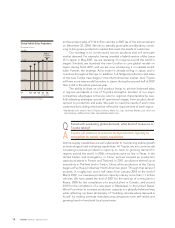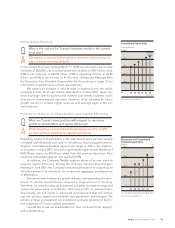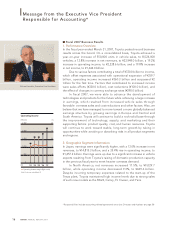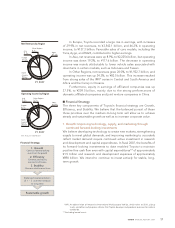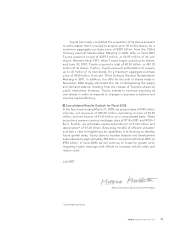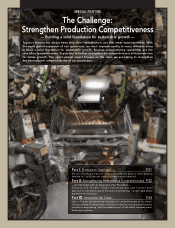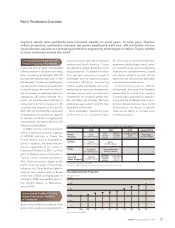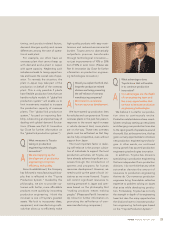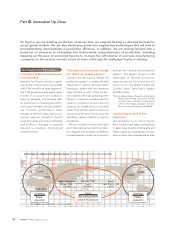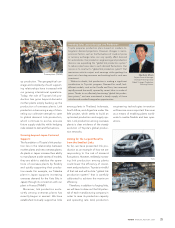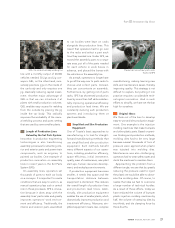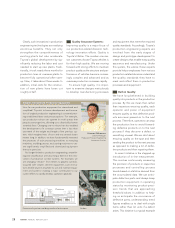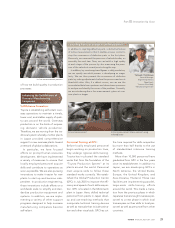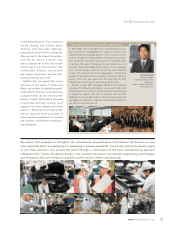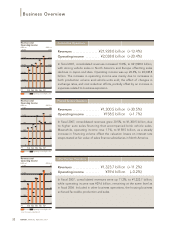Toyota 2007 Annual Report Download - page 25
Download and view the complete annual report
Please find page 25 of the 2007 Toyota annual report below. You can navigate through the pages in the report by either clicking on the pages listed below, or by using the keyword search tool below to find specific information within the annual report.
ANNUAL REPORT 2007 23
timing, and product-related factors,
demand changes quickly and causes
differences among the rate of opera-
tion at each plant.
For example, we often have an
overseas plant that cannot keep up
with demand and a plant in Japan
with spare capacity. Neglecting such
imbalances leads to losing opportuni-
ties and lowers the overall rate of oper-
ation. To remedy the situation, the
plant in Japan may take part of the
production on behalf of the overseas
plant. This is only possible if plants
have flexible production lines that can
handle multiple models. A “global link
production system” will enable us to
limit investments needed to increase
the production capacity of overseas
plants. The “global link production
system,” focused on improving flexi-
bility, is becoming an important way of
dealing with global demand fluctua-
tions. (Please see Part III: Innovation
Up Close for further information on
the “global link production system.”)
What measures is Toyota
taking in production
engineering technologies
innovation?
We are stepping up the
development of production
engineering to improve
efficiency and quality.
Since its establishment, the Company
has followed a manufacturing philoso-
phy that is reflected in the “Toyota
Production System.” Guided by this
philosophy, we aim to provide cus-
tomers with better, more affordable
products more quickly by innovating
production engineering. I think this
mind-set is one of Toyota’s greatest
assets. We look to incorporate ideas,
equipment, and manufacturing meth-
ods that allow us to efficiently make
high-quality products with easy main-
tenance and reduced environmental
burden. Toyota aims to dramatically
outperform previous benchmarks
through technological innovation—
not just improvements of 10% or 20%
but of 50% or even more. (Please see
Part III: Innovation Up Close for further
information on production engineer-
ing technologies innovation.)
Would you explain the third chal-
lenge the production-related
divisions are facing: promoting
the self-reliance of overseas
manufacturing companies?
We intend to accelerate
human resources development.
We have started up production lines
for vehicles and components at 16 new
overseas plants in the past five years in
response to the recent rapid increase
in vehicle demand. And, more plants
are on the way. These new overseas
plants must be self-reliant so that they
can be fully competitive, even without
support from Japan.
The most important factor in realiz-
ing self-reliance is the prompt cultiva-
tion of individuals to support the local
production activities. At Toyota, we
have already achieved significant suc-
cesses through the introduction of
systems and programs for human
resources development. However, we
need to pick up the pace of such ini-
tiatives as we move forward. Toyota
will commit significant resources to
training personnel in Japan and over-
seas based on the philosophy that
“making products means making
people.” (Please see Part III: Innovation
Up Close for further information on
promoting the self-reliance of over-
seas manufacturing companies.)
What advantages does
Toyota have that will enable
it to continue production
innovation?
Our advantages are the depth
of our engineering team and
the many opportunities that
we have to innovate production
engineering technologies.
We believe it is vital for our produc-
tion sites to continuously evolve.
Production-related divisions have recent-
ly been very busy starting up new plants
and changing over production lines due
to the rapid growth of operations around
the world. But, at the same time, this has
given us many opportunities to introduce
new production engineering technolo-
gies. In other words, our continued
strong growth has spurred production
engineering technologies innovation.
In addition, Toyota has divisions
specializing in production engineering
that are independent from production
divisions. I do not think that any other
automaker devotes the amount of
resources to production engineering
that we do. Our numerous production
engineers bring formidable collective
expertise to problem solving on issues
that arise while developing produc-
tion. Fortunately, Toyota has not only
the strength in depth of its engineering
team but also the many opportunities
the divisions have to innovate produc-
tion engineering technologies based
on the “Toyota Production System.”
Q
A
Q
A
Q
A



